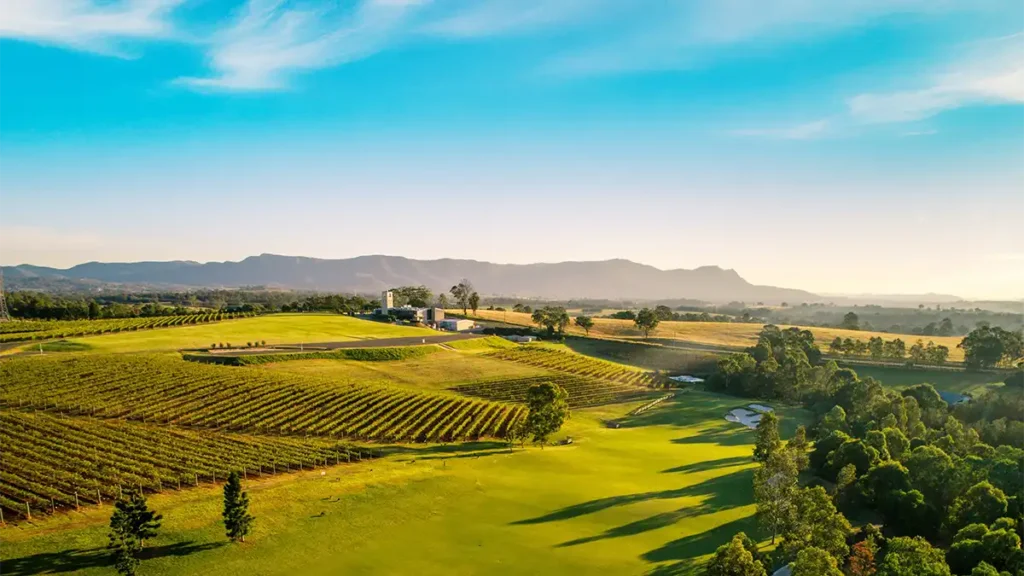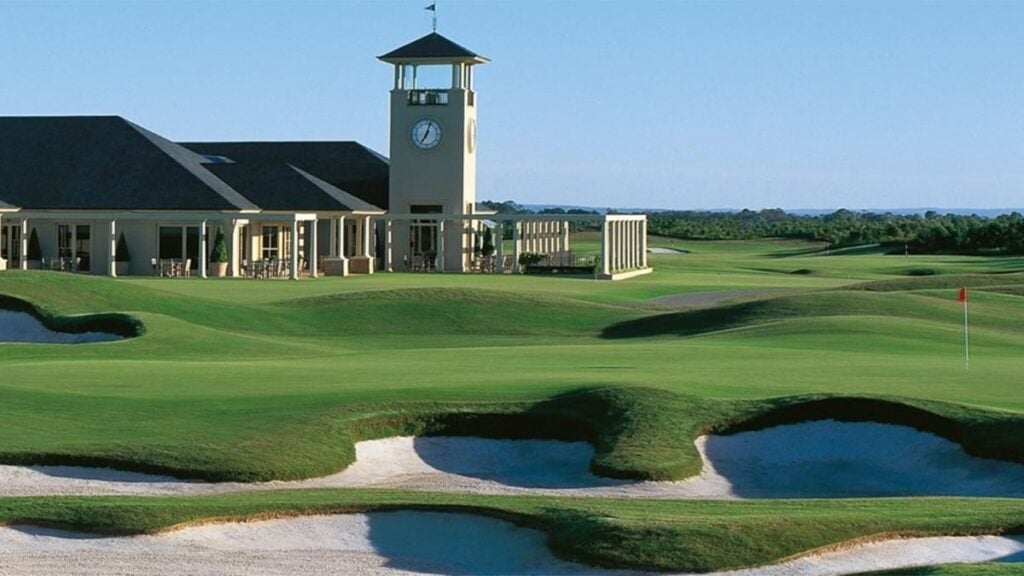How a group of pioneering golfers used their vision, and naturally stunning farmland surrounded by dunes, to create a renaissance of links courses that reshaped Australian golf.
Mike Clayton plays golf quickly, and he always – always – walks. He’s a Victorian at heart, despite being a globetrotting European Tour winner and one of the world’s premier golf course architects. On a blustery Friday afternoon in September, which featured bouts of heavy rain, the co-creator of the newly minted 7 Mile Beach course in Tasmania agreed to play 18 holes with Australian Golf Digest to help answer the question this story seeks to answer: who were the pioneering golfers that made the Mornington Peninsula the otherworldly golf destination it is today?
With a Sunday carry bag over the shoulder, Clayton marches up the hill to the first tee at St Andrews Beach Golf Course – designed by Tom Doak with Clayton a contributor. By no means does Clayton attempt to claim he was one of the men who made the Mornington; he didn’t know about that line until your correspondent asked to play golf and pick his brains. But Clayton is a certainly an expert on a golf-blessed peninsula that sits 75 minutes from Melbourne; he has past and present architectural projects on the Mornington, and he lives there. During the COVID-19 pandemic, when Victorians were cruelly denied access to a game that affords hours of fresh air, sunshine and human interaction, Clayton hit 5-irons along St Andrews Beach.
Standing on the elevated first tee at St Andrews Beach and looking around at the rugged sand dunes and farmland called “The Cups”, it’s easy now to see how golf was almost pre-ordained for this land. Certainly, Doak, when contacted by Australian Golf Digest, saw it that way. “St Andrews Beach may be the best example of my design philosophy, and the course that I wish I had in my back yard; [ironically, it’s Clayton who owns a house nearby],” Doak says via e-mail. “It was a beautiful piece of land for golf, and it didn’t take much to build it. Most of the greens took a matter of hours to build, so really, digging the bunkers was the lion’s share of the work. The rest of the course just needed mowing out and re-grassing.”
But golf course architecture, and specifically, destination architecture, has come a long way in the past three decades. In the 1970s, it was far less of a certainty that if you built world-class golf courses with timeless designs, people would come. And more importantly, keep returning.
Clayton is adamant the Mornington Peninsula’s timeline starts with a man named Colin Campbell, a golf professional and course developer who originally constructed The Cape Country Club at Cape Schanck in 1972.
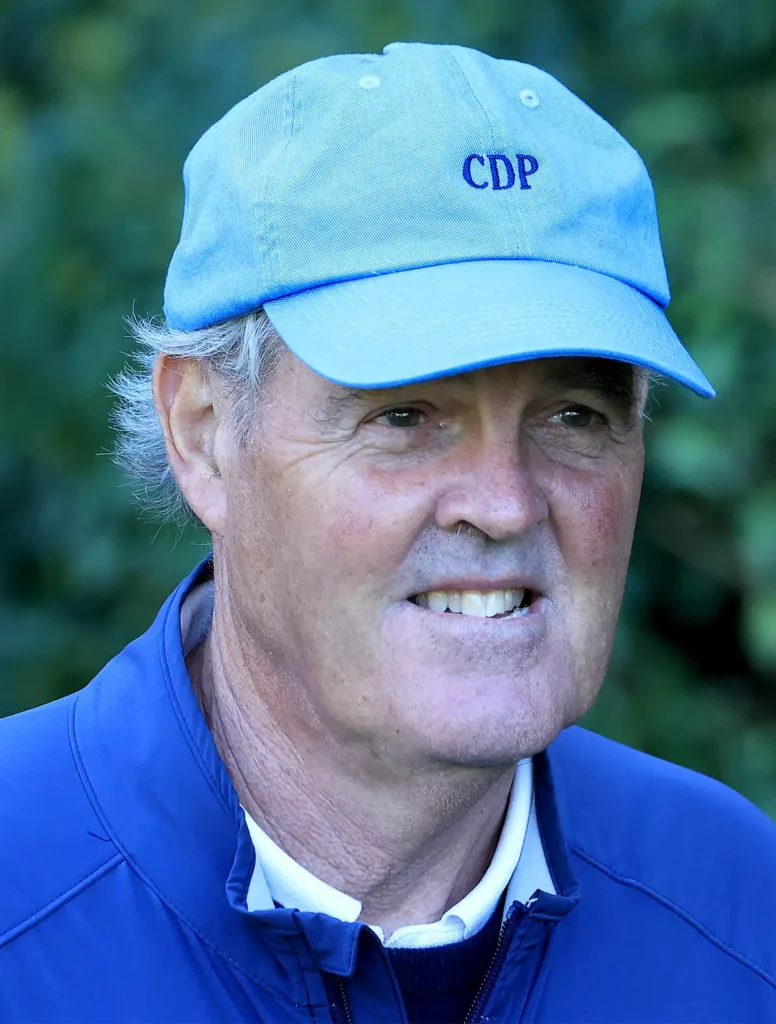


“I knew [Campbell] a little bit,” says Clayton, who along with Mike DeVries and Frank Pont jointly form Clayton DeVries Pont (CDP) Golf Design. “He was the first one to recognise how good [and expansive] the land was on that part of the peninsula. There were no golf courses out there; there were the old traditional clubs like Rosebud Country Club, Flinders, Portsea, Sorrento, but that was it.
“There was nothing on [the Cape Schanck] part of the peninsula, which was incredible land for golf. He took a punt on it; by hand, he built the course, when there was no money, and the roads [from Melbourne and within the peninsula] weren’t as developed. He was the one who had the wherewithal to go and build golf out there. I’m sure people have driven down Boneo Rd, looked to their right, and thought, That would be good land for golf. He was the first guy who went and actually did it.”
During the next 20 years, Campbell was asked by a local butcher to construct a golf course in Rye called Limestone Valley, although it was never finished. The land was sold to another visionary, prominent businessman Duncan Andrews, who in 1995 turned the property into one of Australia’s defining golf courses: a links course bearing almost no trees that appeared to have been transported from Ireland and simply dropped onto the rolling hills and rustic Victorian farmland. It was called The Dunes Golf Links. In the hard-to-picture days prior to Moonah Links (2001), St Andrews Beach (2005) and the Ocean/Gunnamatta course at The National (2000/2019), modern links golf, sans trees, hardly existed in Australia. Andrews engaged architect Tony Cashmore to take the partially built Limestone Valley, which used deep valleys for its holes, and transform the property into a majestic course featuring generous fairways routed between dunes and across ridges. Plenty of the greens were built in eye-catching hollows or sitting on shelves.
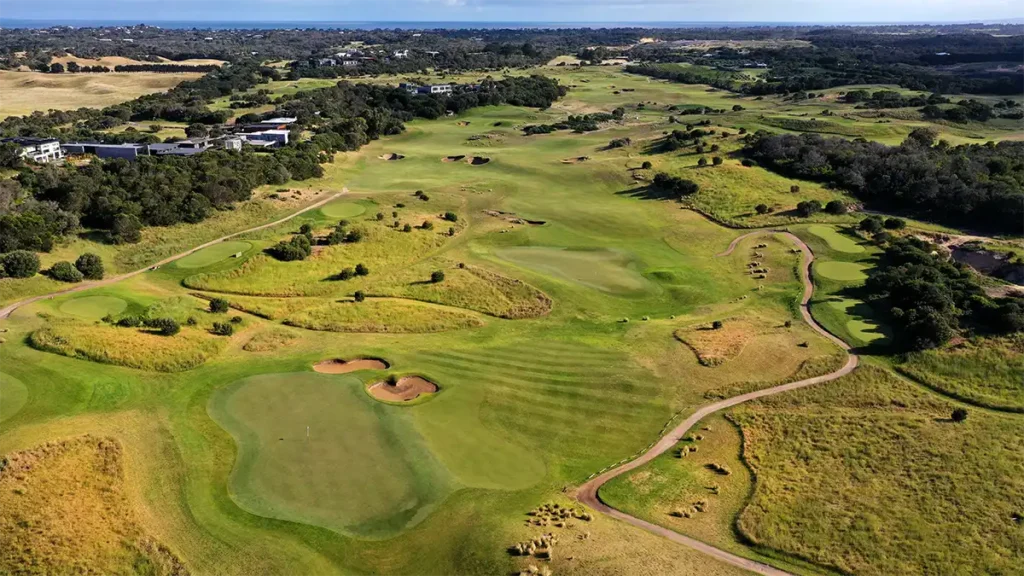
But where did Andrews’ vision, and the brilliance of Cashmore, begin?
“I came across this sign on Browns Rd, Rye, saying, ‘Mortgagee auction,’” Andrews tells Australian Golf Digest. “I’ve played quite a lot of golf in Ireland and Scotland. Just by chance, I drove by with my wife and looked at this land [and said], ‘God, that’s beautiful. Just like Ireland and Scotland.’
“I’m not gilding a lily, but it had no trees at all. Now, that’s important. Everything in Australia had trees until then. The concept of a links course, people talked about it, but it didn’t exist in truth. [With] no trees, [The Dunes] was going to become a bit of a risk. And I thought, Well, people love Scotland and Ireland, so why wouldn’t they love this if we tried to put a golf course there? It’d never been one before.”
In that treelessness, Andrews saw both risk and liberation. Australia’s golf, by and large, grew up under or beside branches. Here was a chance to build something that played with wind and width, bounce and angles – the language of links. Once built, he said 20 and 30-handicap golfers were enjoying the style, so he knew it was a hit.
In its present-day form, The Dunes is a sight to behold, and it is highly recommended guests stay in the stylish accommodation on-site to allow for a short walk down to the 18-hole course and its sister nine-holer, The Cups. From start to finish, it is hard to fault any of the holes at The Dunes. This writer’s favourite offerings were the short and tricky par-4 fourth (golfers: please take a long iron off the tee), the par-5 fifth with its marvellous bunkering, and the par threes at 13 and 17.
“Duncan was absolutely spot on when he said, ‘We need a golf course that can appeal to everybody regardless of your ability,’” Cashmore tells Australian Golf Digest. “The Dunes is a course, which, even if you can’t play very well, you don’t lose a ball easily. And if you just play moderately to your handicap, you’ll get a great deal joy out of the game. So, what am I most proud of? That it succeeds in being a fun course to the broadest possible range of golfers.”
The Dunes is completely public and affordably priced. Many key figures in Australian golf nominate it as a momentous course given that its success spurred on the peninsula’s golf tourism landscape, now a healthy industry in 2025. Moreover, its respect in architecture circles inspired a quest for natural, minimalist golf with interesting design. Without it, golf courses in Tasmania and Victoria may not have been built.
“Duncan Andrews had a very good assessment of what golf should be about, in my opinion,” Cashmore says. “Colin Campbell’s work on the original Limestone Valley created some of that early treeless link golf. I was just an early contributor and finished the job, but The Dunes and what it’s about inspired, I guess, other architects and developers to come in and create courses like The National Golf Club, Moonah Links and others.”
Andrews measures success simply. “That it’s successful, that it worked, and that we didn’t try to be something else; we just tried to be a public golf course that brought private-club standards,” he says.
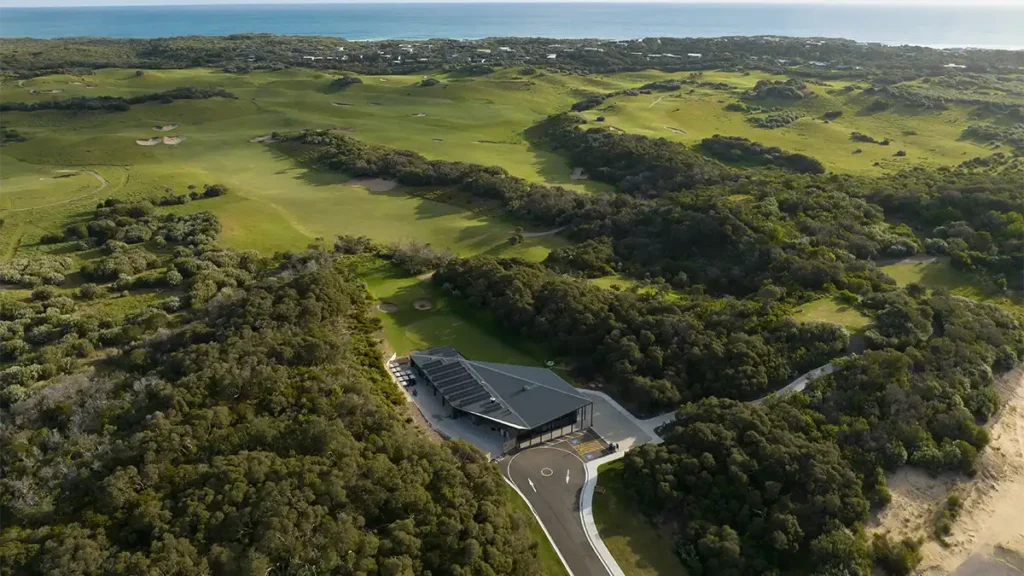
MINIMALIST WAYS
If The Dunes was proof of concept, St Andrews Beach was a masterclass in minimalism. Clayton describes walking the property in the Cups region with Doak before a single green was shaped.
“It’s perfect land for golf, really,” Clayton says. “I walked St Andrews Beach before there was a course there. Tom did that [original] routing with Ian Baker-Finch. I mean, literally almost nothing got moved on that site. Great golf was laying all over it. It was just a matter of digging out the bunkers and shaping the greens. Both the new courses at The National were the same, really.”
Then there’s Peter Thomson. His contribution to the region was also immense, through Moonah Links. Almost 25 years ago, the five-time winner of the Open Championship and his design partners created Moonah Links, turning grazing land into “The Home of Australian Golf” with the Open course – the country’s only purpose-built layout for the Australian Open – as well as practice and coaching facilities. The Open course was finished in 2001 and hosted our national championship in 2003 (won by Peter Lonard) and 2005 (Robert Allenby). From the back tees, it is one of the toughest courses in the country, with blind shots routed through ancient dunes and heavy winds. But played from the correct tees, it is far more forgiving and a thoroughly enjoyable test of golf. Moonah Links now stages the Victorian PGA Championship and tour qualifying schools, continuing its storied history with the PGA Tour of Australasia.
The second course at Moonah Links, the Legends, was designed by Ross Perrett and offers a contrasting, more forgiving layout through valleys and Moonah trees. Among the endless highlights, the thrilling downhill tee shot at the fourth and the dunescape holes beginning at the 11th stand out. The Legends is world-class fun while the Open is a most enjoyable type of challenge: using every club in the bag, with strategy paramount to your score. Together they form a complementary duo that make for a great golf getaway. With the adjoining Peppers Resort on site, Moonah Links can act as lone destination – if you can resist the temptation to play elsewhere.
If anything, the modern designs introduced to the Mornington shone a new light on great golf that existed well before the 1990s, although not necessarily for golf trips from out of state and from overseas. Now, Portsea, Sorrento, Flinders and courses are being celebrated again. And they’re getting love from renowned architectural firms such as Clayton, DeVries & Pont (CDP) and KruseGolf, who have been appointed to the wonderful Portsea Golf Club. Portsea was originally created as a nine-hole course in 1924 by Scottish pro golfer Jock Young, among tea-tree covered sand dunes surrounding Point Nepean National Park. It became an 18-hole layout in the 1960s.
More than a century since its inception, Clayton will oversee the Portsea project and will be assisted by Harley Kruse, Lukas Michel and DeVries. Their plan is to introduce fescue into the fairways and make overall improvements to a world-class layout. “The back nine is one of the best in the state and, by definition, the country,” Clayton said via an announcement when CDP and KruseGolf were appointed consulting architects earlier this year. “Our task is to bring the opening nine up to the same standard. There’s also a big space by the new clubhouse to make a great short-game area, something which members have never had. The course can undoubtedly be elevated to another level.”
Portsea’s layout offers a sound mix of short and long holes. For the former, thoughtful short par 4s can be found at the 10th (256 metres) and 15th holes (267 metres), while the par 3s are all exciting, notably at the second, which occupies a secluded shelf within the land and plays to a green set in a small dell. Of the longer and more challenging holes, the 395-metre fourth, the 14th, 17th and 18th balance out the par 3s and short par 4s for a diverse test. Three par 5s don’t reach 500 metres (the third measures just 436), but the meandering fairways demand precision.
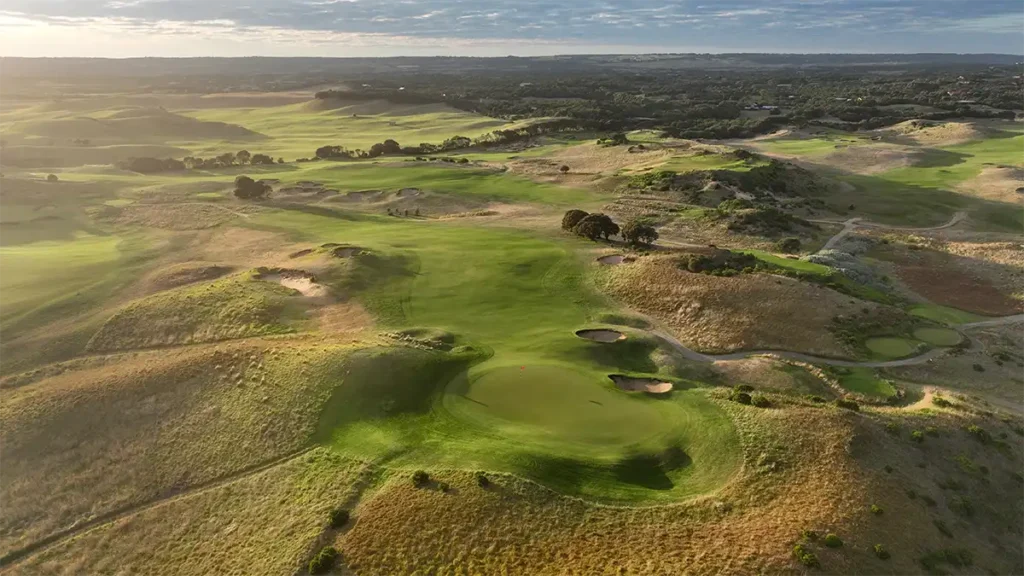
THE BEAUTY, AND FUTURE, OF THE MORNINGTON
To understand the Mornington’s impact on Australian golf, Clayton argues, is to understand Sand Hills Golf Club in Nebraska’s influence on American and international modern course architecture. He draws a straight line through Nebraska to Oregon to Australia, mainly Tasmania and Victoria’s Cups region.
“Sand Hills was the first great modern course, really,” Clayton says. “If it wasn’t for Sand Hills, Bandon Dunes might not have been built. If it wasn’t for Bandon Dunes, Barnbougle might not have been built, and it wasn’t for Barnbougle, 7 Mile Beach might not have been built. The land on the [Mornington] Peninsula is very similar to that land in Nebraska.
“[Golden Age course architect Alister] MacKenzie wrote about it: the future of the game is tied to interesting golf, and golf that inspires people to play, and encourages people to keep coming back.”
Good news, then, that Mornington golf does not appear to be done. A short drive around the region allows any golf-course architecture fan to feel there are swathes of promising terrain still in play; and the appetite for interesting golf has never been stronger.
“Indeed, my favourite memory of the course was playing several holes with Mike [Clayton] during pre-construction… on the mowed-out land, though I think all of the holes we played were on the second 18, the Fingal course, which never got built,” Doak says. And with Melbourne’s metropolitan growth almost tapped out, Clayton believes it’s a natural progression.
“I think, in the long term, there’s a lot more golf you can build [on the Mornington] because I think there’ll be more people playing golf, and there’ll be perhaps fewer courses in the city, and [the Mornington is] the obvious place to go,” Clayton says.
“Everyone loves building exciting golf courses, and there’s land next to The National… there’s room for five courses there. I mean, whether it gets built is another question, and there’s room for another course at St Andrews Beach.”
So, who were the golfers that the Mornington? Well, the answer I found on my trip was a pleasant surprise. While there is a clear list of visionaries who delivered a world-class golf destination, it isn’t the finished product. The Mornington is still being made, and that’s victorious for golfers in Australia and around the world.


